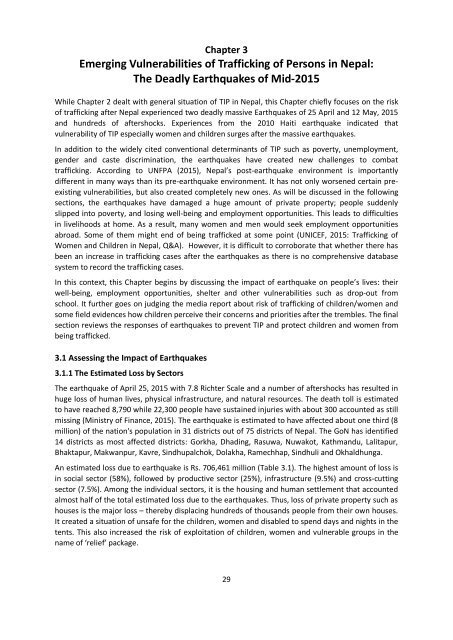TRAFFICKING IN PERSONS
397604438Trafficking_in_Persons_National_Report_2013-15
397604438Trafficking_in_Persons_National_Report_2013-15
Create successful ePaper yourself
Turn your PDF publications into a flip-book with our unique Google optimized e-Paper software.
Table 3.2 Population estimated affected by the earthquakes, Nepal<br />
Number<br />
Total population 5,700,000<br />
Total women’s population (50.5%) 2,710,239<br />
Female headed households (26.5%) 326,943<br />
Women with disabilities 39,987<br />
Elderly women (65 + years 6% of the total female population) 163,043<br />
Girls under 14 years of age (28% of the total female population) 764,226<br />
Illiterate women (29% of the total female population) 794,529<br />
Dalit population (16.3%) 929,000<br />
Number of children out of school 1,399,000<br />
Pregnant and lactating women 126,000<br />
Number of women at risk of gender-based violence 40,000<br />
Source: Gender Equality Bulletin No. 1.<br />
3.1.3 Increase in Number and Proportion of Poor<br />
According to the World Bank estimate (2015)5, the proportion of poor in Nepal will increase by 2<br />
percent (on the assumption of low impact), by 2.8 percent (on the assumption of medium impact) by<br />
3.7 percent (on the assumption of high impact) into poverty in 2015/16. The proportions and<br />
number of poor would substantially increase in mountains and central hills of Nepal. With the<br />
assumption of medium-impact of the earthquake on the Nepalese economy, the proportion of poor<br />
in mountains would increase to 43.8 percent from 35.9 percent; and in central hills, it would<br />
increase from 25.8 percent to 41.2 percent. The absolute number of poor at the national level, on<br />
the assumption of earthquake impact of low, medium and high scenarios, will be 561,000; 786,000<br />
and 1038,000, respectively. Almost half number of poor of Nepal would be in central hills. Thus,<br />
central hills and mountains would be the pocket of poverty-hit areas coupled by the emotional and<br />
psychological distress. This is one of the crucial vulnerability situations of all persons including<br />
children, young, adult, elderly, men and women.<br />
Table 3.3 Poverty impact earthquake of April 25, 2015 and aftershocks under three scenarios<br />
% of poor Low impact Medium-impact High impact<br />
(Baseline<br />
no<br />
earthquake<br />
scenario<br />
2015)<br />
% poor Number<br />
of poor<br />
(in ‘000)<br />
% poor Number of<br />
poor (in<br />
‘000)<br />
% poor Number of<br />
poor (in<br />
‘000)<br />
National 21.2 23.2 561 24.0 786 24.9 1038<br />
Mountains 35.9 41.1 102 43.8 152 45.1 180<br />
Urban<br />
Kathmandu 9.4 12.1 43 13.0 56 14.6 82<br />
Other hills 7.3 7.8 6 7.8 6 7.8 6<br />
Rural<br />
Eastern<br />
hills<br />
13.0 13.7 13 14.1 19 14.2 22<br />
Central<br />
hills<br />
25.8 36.6 280 41.2 395 45.1 500<br />
Western 21.8 24.3 66 25.8 106 27.1 141<br />
hills<br />
Source: NPC, 2015a.<br />
5 The World Bank (cited in NPC, 2015) carried out the impact of earthquakes of April 25 and aftershocks on poverty level in<br />
Nepal under three different scenarios: low, medium and high impact. Four indicators were taken into account: i) % loss<br />
of housing and durable assets loss (50%, 70% and 100% for low, medium and high, respectively); ii) % loss in annual<br />
income loss (35%, 45% and 50% for low, medium and high respectively); iii) % of growth rate in 2015/16 (4.5%, 4.5% and<br />
4% in low, medium and high, respectively) and iv) % increase in foreign remittance (15%, 5% and 0% for low, medium<br />
and high projection, respectively).<br />
31


